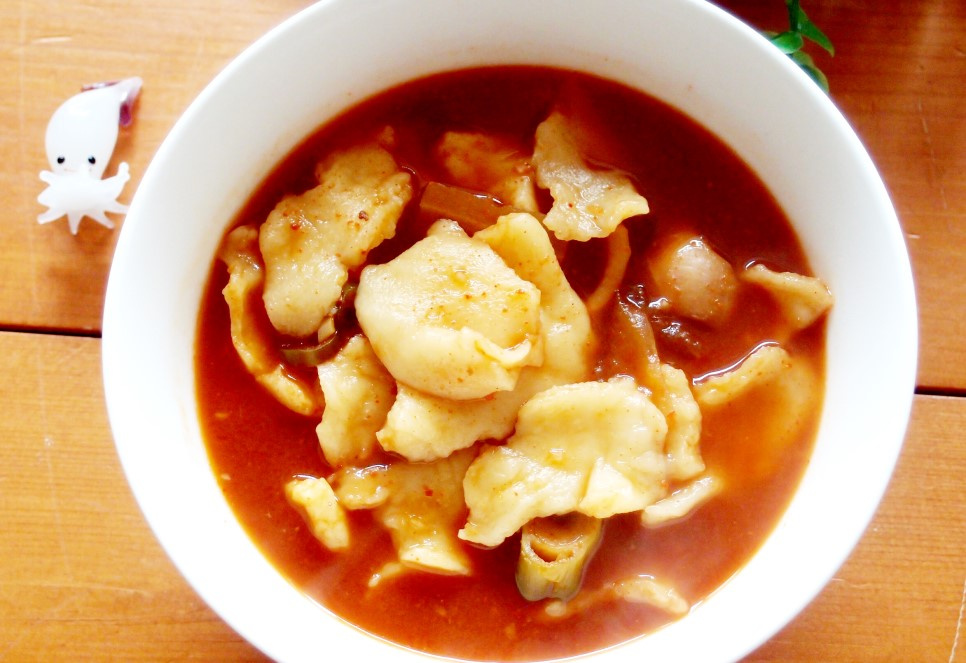Spicy and Refreshing Squid and Gochujang Stew with Handmade Noodles
#SquidGochujangStew #HandmadeNoodles #KalgulNoodles #SpicyStew #ComfortFood

The previous night, we made a generous batch of squid and gochujang stew. We then prepared the noodle dough, let it rest and mature in the refrigerator, and the next day, we added these handmade noodles to the leftover stew. The result is a delightfully spicy and flavorful ‘Squid and Gochujang Stew with Handmade Noodles’! This dish is essentially a delicious way to elevate leftover squid and gochujang stew into an even more satisfying and robust noodle soup. It’s not complicated at all! You can create a richer, spicier gochujang noodle soup using your leftover stew.
Squid and Gochujang Stew Ingredients- 2 squids
- 1/2 zucchini
- 1 onion
- 1 block firm tofu
- 1/3 daikon radish
- 1L natural seasoning seafood broth
- 2 Tbsp minced garlic
- 3 Tbsp chopped green onions
- 3 Tbsp gochujang (Korean red chili paste)
- 1 tsp gochugaru (Korean red chili flakes)
- 2 Tbsp soup soy sauce
- A pinch of black pepper
- Soy sauce to taste
Handmade Noodle Dough Ingredients- 3 cups all-purpose flour
- 1 tsp salt
- Water (as needed to adjust consistency)
- 3 cups all-purpose flour
- 1 tsp salt
- Water (as needed to adjust consistency)
Cooking Instructions
Step 1
We started by making a generous pot of squid and gochujang stew. This involved adding ingredients like tofu, zucchini, onion, and squid to a rich broth flavored with gochujang. We made sure to prepare an ample amount of gochujang broth for an extra deep flavor. The original recipe for this stew can be found here: @6915785.

Step 2
Now, let’s transform the leftover squid and gochujang stew into a wonderfully spicy noodle soup! First, we’ll prepare the handmade noodle dough. In a bowl, combine the flour and salt. Gradually add water, mixing until the dough starts to come together. Continue adding water and mixing until all the dry flour is incorporated and the dough becomes smooth. Once it forms a cohesive ball, it’s time to knead! Knead the dough thoroughly, pressing and folding it until it’s smooth and elastic, resembling the surface of a baby’s bottom. This step is crucial for achieving a chewy texture.

Step 3
After kneading, place the dough in a plastic wrap and give it another good press. Alternatively, you can ‘foot-knead’ the dough (족타) by stepping on it gently. This technique helps to further develop the gluten, resulting in an even softer and chewier noodle texture. Once the dough is ready, wrap it tightly and refrigerate it for about half a day (or at least 2 hours) to let it mature. This resting period allows the gluten to relax, making the noodles more pliable and tender.

Step 4
Here’s the beautifully matured noodle dough, taken from the refrigerator after overnight resting. You can see how smooth and pliable it has become, indicating a wonderfully chewy texture. Take out only the amount you need for your meal. Wrap the remaining dough tightly and store it in the refrigerator for future use, or portion it and freeze it for even longer storage.

Step 5
This is how wonderfully stretchy the matured dough is! Its smooth surface pulls like melted cheese. Once the squid and gochujang stew is at a rolling boil, it’s time to gently tear off pieces of the dough and drop them into the simmering stew.

Step 6
You can tear off the dough pieces to your preferred thickness. If you like thick, hearty noodles, make them thicker. If you prefer thinner noodles, make them as thin as possible. I personally enjoy the bite of thicker noodles, so I made them quite substantial. To tear the noodles, hold a piece of the dough in one hand and use the other hand to stretch and pull it thinly to your desired size before dropping it into the stew.

Step 7
The stew is ready once the noodles are cooked through. You’ll know they’re done when the white noodle pieces float to the surface of the broth.

Step 8
And there you have it – our delicious Squid and Gochujang Stew with Handmade Noodles! The combination of chewy, homemade noodles and the rich, spicy broth is truly delightful. This dish perfectly captures why gochujang noodle soup is such a beloved comfort food!



